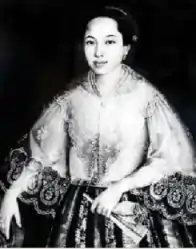Dolores Paterno
Dolores Paterno y Ignacio (March 10, 1854 – July 3, 1881) was a Filipina composer known for the song "La Flor de Manila" (also known as "Sampaguita").[1]
Dolores Paterno | |
|---|---|
 Portrait c. 1870 by Justiniano Asuncion | |
| Born | Dolores Paterno y Ignacio March 10, 1854 |
| Died | July 3, 1881 (aged 27) |
| Nationality | Filipina |
| Education | Santa Isabel College, Manila |
| Occupation | Composer |
| Known for | "La Flor de Manila" ('The Flower of Manila') |
| Style | Romantic |
Biography
Dolores Paterno y Ignacio (anglicized as Dolores Ignacio Paterno or Dolores Paterno-Ignacio) was born on March 10, 1854 in Santa Cruz, Manila, Philippines. She was one of the thirteen children of Maximo Molo Agustin Paterno and Carmina de Vera Ignacio.
Dolores Paterno came from the wealthy interrelated mestizo de sangley families of Paterno, Molo, and Agustin. She was the sister of Dr. Pedro Alejandro Paterno, a Filipino politician, poet, and novelist. Her sisters and stepsisters, Agueda, Jacoba, Paz, Concepcion, and Adelaida, were celebrated painters and jewelers whose works were exhibited at the Exposición Regional de Filipinas in Manila in 1895 and at the St. Louis World's Fair in 1904. She was also related to the Asuncion brothers, among them Justiniano Asuncion who painted her portrait in 1870.[2]
Musically inclined at a young age, she was sent by her parents to the Santa Isabel College, Manila, an all-girls Catholic school managed by the Daughters of Charity. She devoted much of her time to learning the piano. In 1879, at the age of 25 she composed her only known work, "La Flor de Manila" ('The Flower of Manila'), inspired by the sampaguita flower. The lyrics were by her brother Pedro Paterno,[3] based on a poem of the same title written by their mother.
She died at the age of 27 on July 3, 1881.
La Flor de Manila
"La Flor de Manila" is of the Habanera genre (also known as Contradanza or Danza).[4] It was popular during the end of the 19th century and the early period of the American Commonwealth. It has since been considered a Philippine romantic classic. The lyrics were translated from Spanish into Tagalog by the Filipino National Artist Levi Celerio. An arrangement of the song by Rosendo E. Santos, Jr.[5] was also included in the repertoire of the Harvard Glee Club, during their tour of the Philippines in 1961. It was sung by the Graduating Students of Centro Escolar University during their Annual Sampaguita Interlude as their closing number.
Original lyrics
| La Flor de Manila (Original Spanish) |
|
|---|---|
I |
II |
Translated versions
| Sampaguita (Tagalog version by Levi Celerio) |
The Flower of Manila (English version) |
|---|---|
Sampaguita ng aming lipi, |
Lovely bloom of the Sampaguita |
See also
References
- "Dolores Paterno". HIMIG: The Filipino Music Collection of FHL. Retrieved 27 December 2010.
- Brains of the nation: Pedro Paterno, T.H. Pardo de Tavera, Isabelo de los Reyes, and the production of modern knowledge, by Resil B. Mojares
- Isagani R. Cruz (30 June 2006). "A Thousand Years of Filitude". Retrieved 27 December 2010.
- "Sampaguita". himig.sagadalabs.com/. Retrieved 27 December 2010.
- "Blooming Reputation". Retrieved 24 June 2016.
Bibliography
- Camacho (2000). 100 taon, 100 Filipina sa digmaan at sa kapayapaan. Quezon City: Leonarda Navato-Camacho.
- The National Historical Institute (1989). Filipinos in history (vol. 5). Manila: The National Historical Institute.
External links
- La Flor de Manila on YouTube in the original Spanish, performed by Guillermo Gómez Rivera
- Sampaguita instrumental on YouTube, performed by Michael Dadap